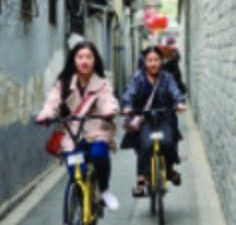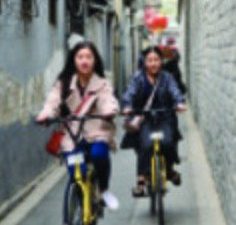Heart of Redemption
May 31, 2017

Beijing does monumental grandeur and epic architecture like no other city – it has the world’s largest palace, the world’s largest public square, the world’s most oddly-angled skyscraper. Yet beneath and between the Forbidden City, Tiananmen Square and the CCTV Tower are areas that are bereft of hyperbolic characteristics – in fact the hutongs of the Chinese capital are mostly renowned for possessing a scruffy charm and chaotic atmosphere.
These alleyways, where two oncoming cars must perform delicate, wall-hugging maneuvers to pass, are enclaves of tradition, where families live in self-contained courtyard compounds. The entranceways are generally a haphazard collage of rusting bicycles, sprouting cables, peeling paint and semi-feral cats; venture inside and there is a small cobbled courtyard with sides flanked by individual rooms, where entire extended families eat, chat and sleep.
The rough simplicity of the hutongs – and the fact that they are some of the last remaining neighborhoods of pre-boom Beijing – make them captivating places to visit. Many hutong homes have already been bulldozed, their occupants not necessarily needing much arm twisting to swap leaking and cold (or hot) hovels for new, high-rise suburban apartments. But plenty remain, including key zones where adventurous entrepreneurs have opened boutiques, restaurants, bars and hotels.
The Soul of the City
In modern Beijing, it’s possible to stay in a hutong hotel that lies a short stroll from the historical Drum and Bell Tower, or quaff a craft ale in a pub that is a two-minute walk from the Lama Temple and enjoy a gourmet meal in a Tibetan temple compound that dates back to the Ming dynasty.
The tiny Orchid hotel is run by Canadian Joel Shuchat. It is located in one of the more rambunctious hutongs, where the air might be filled with the bellowed sales pitch of a passing knife-sharpener, the clanking of pots and pans at the streetside noodle bar and the loud chatter of the pajama-clad local residents.
Yet pass through the doors of the Orchid and the mood is one of total serenity. It has 10 luxurious rooms and a rooftop bar-restaurant that is open to the public for lunch and dinner. On a sunny blue-sky day – and Beijing does have plenty of pollution-free spells, contrary to popular belief – there is a magical upper-deck view over the top of squeezed-together hutong homes and toward the heart of imperial Beijing.
“My fascination with the hutongs is the density and the sense of human scale,” says Shuchat. “If I choose to just watch what is around me something ridiculous will happen every time. There is one guy who I noticed the first time when he took out a French horn from his bicycle basket and gave me a toot. He has now upgraded to a proper trumpet and sits on the side of the street in his crappy pajamas shooting out a few notes.”
The area around the Orchid is also home to other hospitality gems. This was the birthplace of Great Leap Brewing, the city’s pioneer microbrewery, where American Carl Setzer first made his iconic Imperial Honey Ma Gold infused with Sichuan peppercorns, and other pale ales and lagers.
The original, tricky-to-find courtyard location still serves pints, although the two newer branches, located close to the Sanlitun nightlife zone, are larger, classier and offer tasty food options.
“I think the original Great Leap is, aesthetically, the one we love the most,” says Setzer. “[It] was the place that inspired a lot of people to start brewing beer.”
It lies close to the most famous Beijing hutong of all, Nanluoguxiang, a half-mile stretch that is lined with bars, boutiques, cafes, restaurants, backpacker hostels and knick-knack shops. Among the gentrification pioneers was long-term resident Dominic Johnson-Hill, with his Plastered T-shirt store. Plastered is of course slang for a few too many drinks, and the theme of quirky humor, with a Beijing touch, is central to the entrepreneur’s shtick: retro T-shirts feature Beijing subway maps, army-uniformed ballet dancers and Mao Zedong slogans.
“This is the soul of the city, in the hutongs, this is where all the history is,” says Johnson-Hill, who lives in a converted courtyard home. “Here you have a lot of residential; it makes it feel alive.”
A stone’s throw from the main Nanluoguxiang drag is the popular bar-cum-bistro Four Corners, run by Canadian-Vietnamese Jun Trinh. Slightly further afield, on the outer fringes of the Forbidden City, is Temple Restaurant Beijing, situated in a compound that was once used by Tibetan monks to produce scrolls for Ming dynasty emperors. Now, chefs at the venue focus on creating fine-dining European dishes under the watchful supervision of Belgian owner Ignace Lecleir.
“It is a very unique restaurant, it has a lot of charm and character,” says Lecleir. “It is amazing that you are in the middle of a city of 20 million people and it is quiet. You walk outside and it is so relaxing; you almost feel that you are in a small village.”
The analogy is accurate in terms of the friendly atmosphere – with the important qualifier that the Beijing urban villages are rather larger than the average rural settlement. One of the biggest hutongs of all, Dashilar, lies directly next to the fine-dining restaurant Capital M, at the southern tip of Tiananmen Square. It’s the northern outpost of Australian Michelle Garnaut, famed for opening Shanghai’s first free-standing restaurant, M on the Bund.
Simple, But Done Well
Gourmet fare is not, in general, a strong point of the hutong restaurants, partly because of the space constraints. Instead, the proprietors stick to producing simple food well. In the case of Briton Will Yorke, that focus has been primarily on upscale pub dishes using fresh ingredients, personally tested recipes, and of course a proper pint of ale.
Yorke, a fluent Chinese speaker, started with the Vineyard Café in Wudaoying hutong and now has a total of five outlets, including a fully fledged micro-brewery out in the suburbs producing ales with names such as Pilgrim’s Progress, Longbowmen, Seeing Double and the Man with the Golden Hop.
The original Vineyard Café encountered major problems before it opened its doors. Yorke and wife Xu Duan spent their savings on converting a traditional courtyard dwelling for restaurant usage only to find that the entire hutong was earmarked for redevelopment, including their building.
The street ultimately escaped the wrecker’s ball and the Vineyard Café was successful from day one. Other entrepreneurs followed his lead and now Wudaoying is a thriving drag, where the old-style courtyard homes, or siheyuan, have been converted for modern usage. There are Western-style restaurants serving Greek, Spanish and Italian food, and an ever increasing number of boutiques, lifestyle stores and craft shops.
“In the beginning, everyone thought we were completely mad and predicted we were going to fail,” recalls Yorke. “But we were relatively young and prepared to work very hard on the business. With the new micro-brewery, we have ratcheted it up another level in terms of investment and time.”
Unlike most hutongs, Wudaoying is easy to find, located immediately opposite the Lama Temple, a stunning structure that ranks high on the must see list of iconic Beijing buildings. Within striking distance is yet another cozy hutong establishment serving craft beers, Slowboat tap room, a simple but homely place. Founder Chandler Jurinka, an American, is proud of the food, particularly the house hamburger, consistently rated as one of the best in the city in local lifestyle magazine polls.
There are plans for a second Slowboat outlet in the Sanlitun nightlife area, which already boasts two Great Leap Brewing pubs along with Jing-A, yet another spot that specializes in serving craft ales. Among them is Airpocalypse Double IPA, which has a price linked to the city’s notoriously poor air: when the pollution index goes up, the price goes down.
Jing-A is inside a walled former factory compound called 1949 Hidden City, next to the classy Duck De Chine restaurant and across from Okra, where American chef Max Levy rustles up his highly rated Japanese specialties. The gentrification of buildings such as this – and the conversion of hutong buildings for modern lifestyle usage – demonstrates that there is a practical and realistic alternative to the wholesale demolition of centuries of iconic Beijing architectural history.
Among the many ways of exploring this history is to book a trip with Bespoke Travel Company, an outfit that offers various options that focus on the city’s food, culture and history, trips that inevitably involve delving deep into the historical hutongs.
A new – and innovative – way to explore the hutongs is with tour operator Beijing Sideways. Their latest offering is hutong tours by electric scooter, a form of efficient transportation that allows access to the very narrowest of lanes. Pedi-cabs also offer whistle-stop (and potentially expensive – negotiate first) tours of the Hou Hai Lake area hutongs.
But if time allows, there is no better way to take in the hutongs than an aimless wander, with a decent map in hand. Nanluoguxiang and its offshoots, the shores of Ho Hai Lake or Wudaoying and its surrounding lanes all have the texture, smell and flavor of Old Beijing, with a slow and measured pace of life that was once the norm in this city, until it opened up to the outside world.
By Mark Graham




